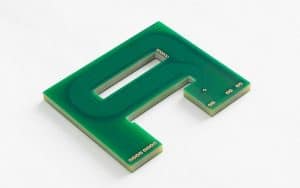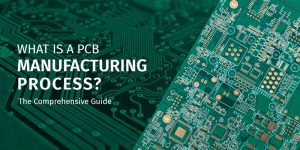Printed Circuit Boards (PCBs) are the backbone of modern electronics, powering everything from smartphones to industrial machines. If you’ve ever opened up an electronic device, chances are you noticed something: most PCBs are green. But have you ever wondered why are printed circuit boards green in the first place?
It’s not just a random design choice. The iconic green color is the result of practical, historical, and ergonomic factors that make green the industry standard. In this article, we’ll explore the 7 key reasons PCBs are green, along with the advantages of green PCB boards, solder mask color options, and how this tradition continues in modern electronics manufacturing.
The Role of the Solder Mask in PCB Design
To understand why PCBs are green, you first need to know about the solder mask.
A solder mask is a thin protective layer applied to the PCB’s copper traces. Its main purpose is to:
- Prevent short circuits during soldering.
- Protect copper from oxidation and contamination.
- Improve electrical performance by reducing leakage currents.
- Make assembly and repairs easier by clearly defining soldering pads.
This layer is what gives PCBs their color. When people ask why PCB solder mask is green, the answer lies in the materials, pigments, and history of PCB manufacturing.
Historical Reasons: Why Was Green Chosen?
One of the strongest factors behind green PCBs is history.
In the early days of PCB manufacturing, solder masks were made from resin-based materials mixed with green pigments. These pigments were widely available and affordable, making green the natural choice. Over time, manufacturers standardized on green because it was both cost-effective and practically beneficial.
This tradition became so strong that today we automatically associate green solder mask PCBs with electronics, even though other color options exist.
Better Visual Contrast for Inspections
One of the biggest reasons for using green solder mask is inspection efficiency.
PCBs undergo rigorous quality checks, including:
- Automated Optical Inspection (AOI)
- Manual visual inspections
- Microscopic fault detection
The PCB inspection contrast green offers is exceptional. Against a green background, copper traces, solder joints, and silkscreen markings stand out clearly. This helps engineers detect defects, solder bridges, or broken connections more quickly.
In fact, studies have shown that ergonomic PCB color choice impacts worker accuracy and reduces eye strain. The green background minimizes glare under bright lights, allowing technicians to work longer without fatigue.
Ergonomics and Human Vision Advantages
Why not use red, blue, or black PCBs instead? The reason again ties to ergonomics.
The human eye is naturally more sensitive to green wavelengths of light. This means:
- Engineers can spot defects more easily on green surfaces.
- Eyestrain is reduced during long inspection sessions.
- High-contrast markings (like white silkscreen text) are more readable.
This ergonomic PCB color choice has made green the most practical option in mass production environments where thousands of PCBs must be checked daily.
Chemical Composition: Solder Mask Resin Pigments
Another reason PCBs are green lies in the chemistry of solder mask resins.
The solder mask is typically made from epoxy resins mixed with solder mask resin pigments. Green pigments proved to be the most stable, durable, and cost-effective during manufacturing.
Green pigments offered:
- High heat resistance.
- Better chemical stability.
- Resistance to fading during UV curing processes.
This made green solder masks more reliable in harsh environments compared to early red or blue alternatives.
Cost-Effectiveness in Manufacturing
Green became the default not just because of history and performance, but also because of manufacturing cost efficiency.
- Green solder mask PCBs are cheaper to produce in bulk.
- Factories are already optimized for green pigment usage.
- Alternative colors like black or white can cost more and may require extra processing.
In other words, the purpose of solder mask color isn’t just visual—it also impacts overall PCB manufacturing reasons, including cost and yield efficiency.
Standardization and Industry Tradition
Finally, PCBs are green because the industry adopted it as a universal standard.
Standardization brings consistency:
- Technicians worldwide are trained on green PCBs.
- Equipment (like AOI machines) is calibrated for green.
- Customers expect PCBs to be green as a sign of authenticity.
Even though manufacturers today offer a variety of solder mask color options, green still dominates because of its longstanding history of reliability and recognition.
Advantages of Green PCB Boards
Now that we’ve covered the reasons behind green PCBs, let’s look at their benefits.
1. Enhanced Inspection and Error Detection
Green solder masks make defects and solder bridges easier to spot.
2. Lower Manufacturing Costs
Green pigments and processes are cheaper compared to alternatives.
3. Better Ergonomics for Workers
Reduced eye strain leads to higher inspection accuracy.
4. Improved UV Resistance
Green resins withstand UV curing and exposure better than some other colors.
5. High Market Availability
Because green is standard, supply chains are optimized for it.
Solder Mask Color Options: Beyond Green
While green dominates the industry, there are several solder mask color options available today:
- Red – Offers a striking look but may reduce inspection visibility.
- Blue – Popular for educational kits and open-source hardware.
- Black – Sleek appearance but harder to inspect and more heat-absorbing.
- White – Common in LED lighting PCBs for better light reflection.
- Yellow/Purple – Less common, mainly for custom or aesthetic projects.
So, can PCBs be colors other than green? Yes, absolutely. However, manufacturers and engineers often prefer green for its practical benefits.
FAQs About Green PCBs
1. What is a solder mask and why is it green?
A solder mask is a protective resin layer applied to PCBs to prevent short circuits and oxidation. It’s usually green because green pigments were historically cost-effective and offered excellent inspection contrast.
2. Can PCBs be colors other than green?
Yes. PCBs can be red, blue, black, white, and even yellow. However, green remains the most widely used because of cost, availability, and inspection advantages.
3. Does the green color affect PCB performance?
No. The color of the solder mask doesn’t directly affect electrical performance. It mainly influences inspection quality, manufacturing efficiency, and cost.
4. Why was green chosen historically for PCBs?
Green pigments were readily available and chemically stable in early resin formulations. Over time, green became the industry standard for reliability and cost-effectiveness.
5. Is green better for visual inspections?
Yes. Green solder masks provide the best contrast for defect detection and reduce eye strain for inspectors.
6. How does solder mask color impact manufacturing cost?
Green PCBs are cheaper to produce because factories are optimized for green resin pigments. Other colors may require extra processing, making them slightly more expensive.
Conclusion
So, why are printed circuit boards green? The answer lies in a mix of history, chemistry, ergonomics, inspection efficiency, and cost-effectiveness.
From the early adoption of solder mask resin pigments to today’s highly optimized manufacturing processes, green has consistently proven to be the most practical and reliable choice. While solder mask color options exist, green continues to dominate because it ensures better visibility, lower costs, and industry standardization.
At the end of the day, the green color of PCBs is more than just tradition—it’s a symbol of efficiency, quality, and reliability in electronics manufacturing.
If you’re interested in learning more about PCB manufacturing, materials, or custom green solder mask PCB production, visit MKTPCB for expert insights and high-quality solutions.











